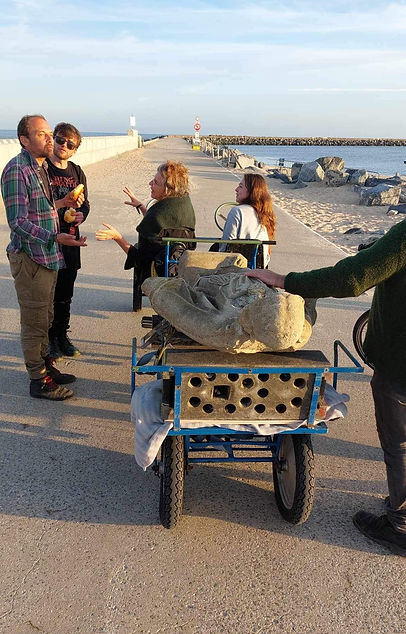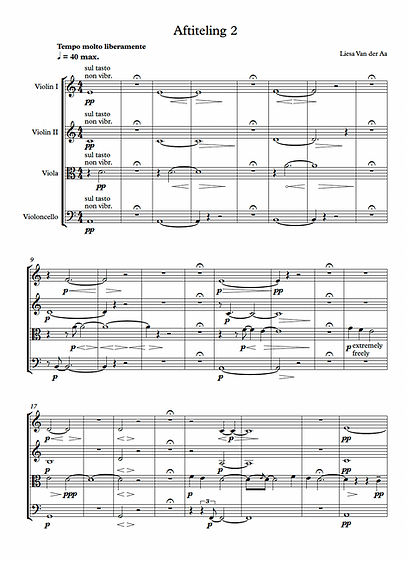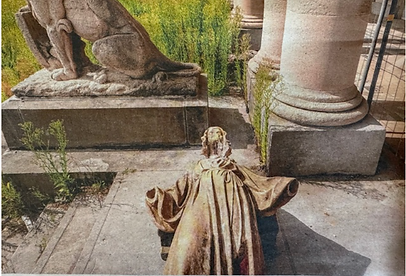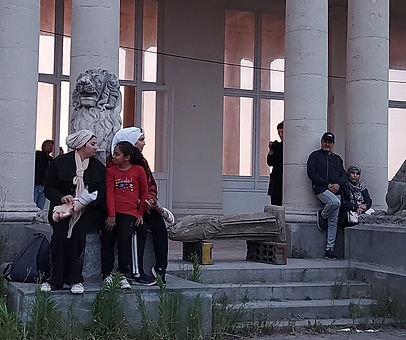Studio Michiels & Vansteenkiste

(the unmoved mover) 2024
performance in collaboration with Liesa Van der Aa and fedasil Jabbeke, for the longest day in Ostende.
(The Unmoved Mover)
Hope and responsibility in a crumbling world
text: Rijana Martinez
In a world where certainties are crumbling and humanism is losing its luster, a disturbing image arises: a broken Jesus figure,
a statue whose hands are missing and whose face has been eaten away by time.
This statue, once a symbol of unshakable hope and strength, now lies battered behind the Royal
Galleries of Ostend, where, with painful precision, it was
wheeled in, resting on a simple gocart and laid down with
a crane. The stone Jesus seems heavy, immobile, and yet it has been put into moved, not only physically, but also in the hearts of the people who surround him.
This performance, performed in the shadow of the dilapidated Thermae Palace, offers more than just a visual spectacle.
When the show moment then comes, it is not only the moment when you see the result, but also the power of the process and the collaboration with the people of Fedasil The idea of connection makes the project more alive and authentic.
A common journey through suffering, but also as a profound
meditation on hope and the human condition.
Pier Paolo Pasolini (°Bologna, 1922- Lido di Ostia,1975), the Italian
director and writer saw in human suffering not only a
physical, but also a mystical dimension. In his work, he explored the
idea that suffering can have a deeper, almost sacred meaning that connects us with something far beyond the material world.
Our contemporary society has a difficult relationship with pain,
suffering and dying. For example, according to psychologist Manu Keirse(°Bruges, 1946), we seem to constantly pretend that the unpleasant sides of life do not exist, perhaps from the thought that in that way we might be able to avoid them. As a result, not
only our natural familiarity with suffering has disappeared, but
that we have also forgotten the language to talk about it.
Kader Attia (b. Seine-Saint-Denis, France 1970), Algerian visual
artist, argues that recovery is only possible for those who face their wounds. He believes not so much in tabula rasa, but rather in growth, change and synthesis between tradition and innovation.
The crumbling of the statue symbolizes the fragility of our
own ideals, of the humanism that once seemed as solid as the
concrete from which the statue of Jesus was hewn. But it also raises questions about our own responsibility and about what we leave behind for generations to come.
Heritage in general, and here in particular, the concrete
statue of Jesus, serves as a tangible reminder of the past and
can bridge the gap between various generations. Monuments carry the stories of people, events and cultures that have
have shaped our society. the concrete statue of Jesus, serves as a tangible reminder of the past and can bridge the gap between various generations.
Monuments carry the stories of people, events and cultures that
have shaped our society. The concrete statue offers solace by immortalizing moments of pain or triumph and giving recognition to those who are in danger of becoming invisible in history. They providerecognition, connecting us to shared experiences and values and help us understand our identity. They form the memory of tomorrow, bringing together past and future in a moment
of reflection and continuity.
On the missing face of Jesus, the people of Fedasil placed
their self-portrait This act constitutes an acknowledgment of the suffering that these people, often marginalized and forgotten, go through. By image, they transform the symbol of suffering into a symbol of hope and collective strength.
The power of this performance, then, lies not only in its ability
to confront us with decay, but also to make us dream
of what could be. A kind of ritual based on solidarity.
The image here is not just “remembrance” of Jesus but expresses a
desire for something better.
Space is created for values that are based on the integrity and rights of the individual. The emphasis on these more or less universally valid values also leads to an increase in attention to the downsides of how we currently deal with refugees.
Imagine that this statue of Jesus is not just a piece of stone ,
but a living, social sculpture - a work of art that not only observes, but also acts and connects.
The public space with the statue thus becomes a site of community action, a place where we can rediscover what it means to be human, to take responsibility for each other and for the world we
share.
The concept of commoning, as the Greek architect and activist,
Stavros Stavrides depicts, also comes together in the
symbolic acts surrounding the Jesus statue. In
Common Space, Stavrides calls for “space” to be viewed as
communal which encourages new forms of social relations and of emancipated communal living. Jesus, The Unmoved Mover, remains a force of hope. Not by his immovability but precisely by his ability to move us, to make us think about what really matters. He calls us to look beyond the crumbling, to fill in the gaps with our
own hands, and to acknowledge the open wounds, not as an endpoint , but as the beginning of something new.




a special thanks to: JP Van Geertruyden, Oscar Van Geertruyden, Michael Vandewalle, Hilde Deleu, Rolf Quaghebeur, Merel Vercoutere, Gudrun Cauwels, Ruth Dupré, Kaap team, Mieke Mels, Ilse Roosens, team Mu.zee, Hilde Gilbos, Evy Vancalbergh, Kriscross.
in collaboration with : Alaa, Denys, Desala, Berektab, Djenabou, Escobar, Hala Dib, Hilde, Jaqueline, Kamara, Kenzy, Kone, Mariam, Meles, Metougue, Nasmia, Nazari, Rukshana, Ndiaye, Oktabas Lassie, Sara, Saoud Al Ramda, Younes, Yvan, Zereamlak, ...
in collaboration with:



























